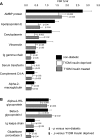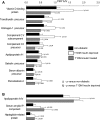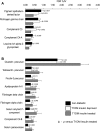Differential effects of insulin deprivation and systemic insulin treatment on plasma protein synthesis in type 1 diabetic people
- PMID: 19654285
- PMCID: PMC2763783
- DOI: 10.1152/ajpendo.00351.2009
Differential effects of insulin deprivation and systemic insulin treatment on plasma protein synthesis in type 1 diabetic people
Abstract
It remains to be determined whether systemic insulin replacement normalizes synthesis rates of different plasma proteins and whether there are differential effects on various plasma proteins. We tested a hypothesis that insulin deprivation differentially affects individual plasma protein synthesis and that systemic insulin treatment may not normalize synthesis of all plasma proteins. We measured synthesis rates of 41 plasma proteins in seven each of type 1 diabetic (T1DM) and nondiabetic participants (ND) using [ring-(13)C(6)]phenylalanine as a tracer. T1DM were studied while on chronic insulin treatment and during 8 h insulin deprivation. Insulin treatment normalized glucose levels, but plasma insulin levels were higher during insulin treatment than during insulin deprivation in T1DM and ND. Individual plasma proteins were purified by affinity chromatography and two-dimensional gel electrophoresis. Only 41 protein gel spots from over 300 were chosen based on their protein homogeneity. Insulin deprivation and hyperglycemia either significantly increased (n = 12) or decreased (n = 12) synthesis rates of 24 of 41 plasma proteins in T1DM compared with ND. Insulin treatment normalized synthesis rates of 13 of these 24 proteins, which were altered during insulin deprivation. However, insulin treatment significantly altered the synthesis of 14 additional proteins. In conclusion, acute insulin deprivation caused both a decrease and increase in synthesis rates of many plasma proteins with various functions. Moreover, chronic systemic insulin treatment not only did not normalize synthesis of all plasma proteins but also altered synthesis of several additional proteins that were unaltered during insulin deprivation.
Figures





Similar articles
-
Impact of type 1 diabetes and insulin treatment on plasma levels and fractional synthesis rate of retinol-binding protein 4.J Clin Endocrinol Metab. 2009 Dec;94(12):5125-30. doi: 10.1210/jc.2009-1331. Epub 2009 Oct 22. J Clin Endocrinol Metab. 2009. PMID: 19850685 Free PMC article.
-
Effects of insulin deprivation and treatment on homocysteine metabolism in people with type 1 diabetes.J Clin Endocrinol Metab. 2006 Sep;91(9):3344-8. doi: 10.1210/jc.2006-0018. Epub 2006 Jun 13. J Clin Endocrinol Metab. 2006. PMID: 16772348
-
Renal amino acid, fat and glucose metabolism in type 1 diabetic and non-diabetic humans: effects of acute insulin withdrawal.Diabetologia. 2006 Aug;49(8):1901-8. doi: 10.1007/s00125-006-0287-3. Epub 2006 May 23. Diabetologia. 2006. PMID: 16718465
-
Protein metabolism in insulin-dependent diabetes mellitus.J Nutr. 1998 Feb;128(2 Suppl):323S-327S. doi: 10.1093/jn/128.2.323S. J Nutr. 1998. PMID: 9478016 Review.
-
Insulin resistance, role of metformin and other non-insulin therapies in pediatric type 1 diabetes.Pediatr Diabetes. 2016 Dec;17(8):545-558. doi: 10.1111/pedi.12337. Epub 2015 Nov 23. Pediatr Diabetes. 2016. PMID: 26592507 Review.
Cited by
-
Insulin Regulation of Proteostasis and Clinical Implications.Cell Metab. 2017 Aug 1;26(2):310-323. doi: 10.1016/j.cmet.2017.06.010. Epub 2017 Jul 14. Cell Metab. 2017. PMID: 28712655 Free PMC article. Review.
-
Concordance of changes in metabolic pathways based on plasma metabolomics and skeletal muscle transcriptomics in type 1 diabetes.Diabetes. 2012 May;61(5):1004-16. doi: 10.2337/db11-0874. Epub 2012 Mar 13. Diabetes. 2012. PMID: 22415876 Free PMC article.
-
Assessment of old and new proteins: a novel methodology.Nutr Metab Cardiovasc Dis. 2013 Dec;23 Suppl 1(0 1):S6-11. doi: 10.1016/j.numecd.2012.05.006. Epub 2012 Jul 10. Nutr Metab Cardiovasc Dis. 2013. PMID: 22784971 Free PMC article. Review.
-
Altered mitochondrial function in insulin-deficient and insulin-resistant states.J Clin Invest. 2018 Aug 31;128(9):3671-3681. doi: 10.1172/JCI120843. Epub 2018 Aug 31. J Clin Invest. 2018. PMID: 30168804 Free PMC article. Review.
-
Identification of de novo synthesized and relatively older proteins: accelerated oxidative damage to de novo synthesized apolipoprotein A-1 in type 1 diabetes.Diabetes. 2010 Oct;59(10):2366-74. doi: 10.2337/db10-0371. Epub 2010 Jul 9. Diabetes. 2010. PMID: 20622162 Free PMC article.
References
-
- Asmann YW, Stump CS, Short KR, Coenen-Schimke JM, Guo Z, Bigelow M, Nair KS. Skeletal muscle mitochondrial functions, mitochondrial DNA copy numbers, and gene transcript profiles in type 2 diabetic and nondiabetic subjects at equal levels of low or high insulin and euglycemia. Diabetes 55: 3309–3319, 2006. - PubMed
-
- Barazzoni R, Meek SE, Ekberg K, Wahren J, Nair KS. Arterial KIC as marker of liver and muscle intracellular leucine pools in healthy and type 1 diabetic humans. Am J Physiol Endocrinol Metab 277: E238–E244, 1999. - PubMed
-
- Bjorkbacka H. Atherosclerosis: cell biology and lipoproteins. Curr Opin Lipidology 19: 215–217, 2008. - PubMed
-
- Carpentier A, Patterson BW, Uffelman KD, Giacca A, Vranic M, Cattral MS, Lewis GF. The effect of systemic versus portal insulin delivery in pancreas transplantation on insulin action and VLDL metabolism. Diabetes 50: 1402–1413, 2001. - PubMed
-
- Chahil TJ, Ginsberg HN. Diabetic dyslipidemia. Endocrinol Metab Clin North Am 35: 491–510, 2006. - PubMed
Publication types
MeSH terms
Substances
Grants and funding
LinkOut - more resources
Full Text Sources
Medical

